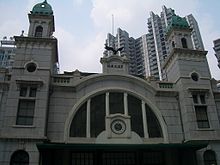Beijing–Hankou railway

The Beijing–Hankou or Jinghan Railway (simplified Chinese: 京汉铁路; traditional Chinese: 京漢鐵路; pinyin: Jīnghàn Tiělù), also Peking–Hankow Railway, was the name of the railway in China from Beijing to Hankou, Hubei Province built in 1905 by Belgian engineers. In 1957, after the Wuhan Yangtze River Bridge was completed, the Beijing-Hankou Railway was connected to the Canton–Hankow Railway and the two railways became collectively known as the Beijing-Guangzhou (Jingguang) Railway. Before the bridge was built, cross-country trains had to be ferried across the Yangtze River in Wuhan between Hankou on the north bank and Wuchang on the south bank. The crossing could take up to an entire day.
From 1928 to 1945, when Beijing was known as Beiping, the Beijing-Hankou Railway was known as the Beiping-Hankou or Pinghan Railway. During the Second Sino-Japanese War, the Japanese advance into central China was known as the Beiping–Hankou Railway Operation.
History
In 1907, Liang Shiyi proposed the formation of a Bank of Communications to redeem the Beijing–Hankou Railway from its Belgian owners.[1] The Bank of Communications was formed in 1908 and provided more than half of the financing needed to buy the railway, the remaining coming from the Imperial Bank of China and the Ministry of Finance.[2] The railway was placed under Chinese control on January 1, 1909, and the successful redemption enhanced the prestige of Liang's Communications Clique.
References
- ^ Dayer, Roberta Allbert (1981). Bankers and Diplomats in China, 1917-1925: The Anglo-American Relationship. Abingdon, UK and New York: Frank Cass. p. 22. ISBN 9781135167585.
In 1907 Liang Shih-i proposed the establishment of a Bank of Communications which would handle domestic and foreign funds for the redemption of the Peking-Hankow railway.
- ^ Lee, En-han (1977). China's Quest for Railway Autonomy, 1904-1911: A Study of the Chinese Railway-rights Recovery Movement. Singapore University Press. p. 223.
... three domestic loans of 5,000,000 taels, 1,000,000 taels, and 7,500,000 taels (CH$10,000,000) each, to be made through the Ministry of Finance, the Imperial Bank of China (ta-ch'ing yin-hang) and the Bank of Communications respectively. The loan provided by the Bank of Communications would be repaid by the issuing of internal bonds.
See also
- Rail transport in the People's Republic of China
- List of railways in China
- Beiping-Hankou Railway Operation (battle along railway line)
"People's Republic of China" is an invalid category parameter for Template:Coord missing.
The problem is usually caused either by a spelling mistake or by an-over-precise category.
For a full list of categories, see Category:Unclassified articles missing geocoordinate data and its subcategories.
